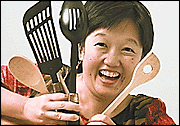Advertisement - Click to support our sponsors.


By Request

LATELY, the mail has been full of requests for Filipino desserts, something Alfredo Cabacungan sees as a positive sign for interest in this overlooked cuisine. Readers crave
Filipino sweetsCabacungan is department chair in the Food Service and Hospitality Education Department, Culinary Arts, at Kapiolani Community College, where his teaching specialty is Asian cuisines.
He is a native of Kauai, with a history in the hotel and restaurant industry that begins with a dishwashing job and runs through executive chef positions at the Kauai Surf, John Dominis on Oahu, a resort in Malaysia and Waialae Country Club, to mention just a few. Cabacungan's parents hail from northern Luzon, though, and he is a well-traveled student (and eater) of Filipino cuisine.
He is also an inveterate collector of cookbooks and combed through them to find these recipes in response to reader requests. First up is Joe in Seattle, who is looking for a dessert called Banana Q. It's basically a banana on a stick, coated in a sugar syrup. Sort of like a candied apple.
Cabacungan says it is similar to a traditional Chinese dessert and bases his recipe on that.
Next up is a request for Peche-Peche, from Carino Fajardo: "This is a Filipino delicacy made of cassava and coconut milk and sugar." Fajardo has had it at Golden Coin Bakeshop, but that establishment doesn't give out recipes, so again we turn to the professor.
He dug out a recipe for Peche-Peche from a local cookbook. The dessert is made, he says, not of cassava, but of mochi rice and Filipino purple rice.
Now, here is where we discover one of the quirks of Filipino cooking. It turns out Golden Coin does sell a small treat made from cassava called Pitchi-Pitchi. Peche-Peche or Pitchi-Pitchi? Because of the number of provinces, cultures and dialects in the Philippines, pinning down a specific recipe can be an elusive thing, Cabacungan says. Adobo, for example, comes in perhaps 150 to 200 varieties.
"It's one of the fascinating things about that country," he says.
But at any rate, in an effort to be somewhat helpful to Fajardo and others interested in sweet mochi treats, the Peche-Peche recipe follows. I haven't yet located Pitchi-Pitchi, so anyone who has a clue -- please get in touch through one of the ways listed at the end of this column. I am also still in search of a recipe for Hopia, a turnover filled with mung-bean paste.
Cabacungan also provides here a recipe for Ube Cake, an item requested by several readers.
Banana Q
Alfredo Cabacungan, Kapiolani Community College4-6 ripe sweet bananas
4 ounces sugar
2 tablespoons water
1 tablespoon lard or salad oilSkewer the bananas and set aside.
In a sauce pan or wok, combine water, sugar and lard or oil and cook until caramel in color (hard ball stage, 250-260 degrees). Remove pot immediately from the heat and dip bananas. Cool slightly. The coating should begin to harden as soon as it hits the air.
Place bananas in a dish lightly greased with vegetable oil to prevent sticking.
Note: Bananas may also be sliced, dropped into coating and spooned out.
Peche-Peche
"Hawaii Filipinas Favorite Recipes, Filipino Women's League, 1999, $16.952 cups mochi rice
2 tablespoons pirurutung (purple rice), soaked overnight (see note)
2 cups water
1/2 cup sugar
1-1/2 cups fresh grated coconutRinse mochi rice and drain. Transfer to a rice cooker; add the purple rice and water. Cook until rice is tender, about 20 minutes. Add sugar and mix well before the water evaporates. Cool.
Form rice into balls about 1-1/4 inches across. Roll in grated coconut to coat. Makes about 50 balls.
Note: Pirurutung is a short-grain purple rice available in Filipino groceries. It is not the same as Thai purple rice, which is long-grain and actually black before cooking.
Steamed Ube Cake
"Filipino Cuisine," by Gerry G. Gelle, Red Crane Books, 1997, $302 cups purple yam, washed, peeled and cubed
2 cups sweet rice flour
1-1/2 cups water
1 cup sugar
1-1/4 cup coconut milk
4 tablespoons baking powder
1/2 cup grated coconutCover yams with water and boil until tender or soft. Drain and put through a ricer. Mash until smooth.
Mix flour and water in a bowl to form a thick batter. Add sugar and mashed yams. Blend well. Strain to remove lumps. Add coconut milk and the baking powder and mix well.
Pour mixture into greased muffin pans to 2/3 full and steam over boiling water about 30 minutes, or until a toothpick inserted comes out clean. Serve hot, warm or at room temperature, topped with coconut. Makes 3 dozen cakes.
Nutritional information unavailable.
Food Stuffs: Morsels
Send queries along with name and phone number to:
By Request, Honolulu Star-Bulletin Food Section,
P.O. Box 3080, Honolulu 96802.
Or send e-mail to bshimabukuro@starbulletin.com
Asterisk (*) after nutritional analyses in the
Body & Soul section indicates calculations by
Joannie Dobbs of Exploring New Concepts,
a nutritional consulting firm.